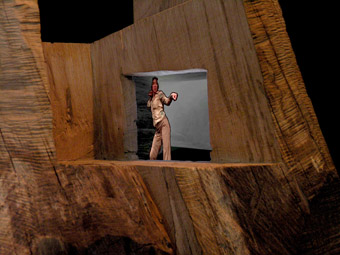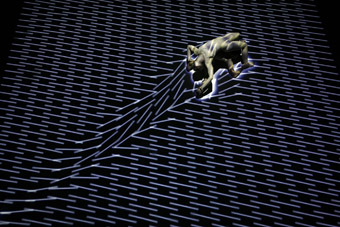engineering the arts
kate warren talks with arts problem solver frieder weiss

Habitat, LaborGras, Volker Schnüttgen and Frieder Weiss
photo Volker Schnüttgen
Habitat, LaborGras, Volker Schnüttgen and Frieder Weiss
FRIEDER WEISS LIVES IN NÜRNBERG AND BERLIN AND WORKS AS AN ARTS “PROBLEM-SOLVER” IN EUROPE AND INTERNATIONALLY, USING HIS INNOVATIVE VIDEO MOTION SENSING SOFTWARE TO COLLABORATE ON DANCE, PERFORMANCE, THEATRE AND INTERACTIVE INSTALLATION PROJECTS. HE HAS COLLABORATED WITH MELBOURNE’S CHUNKY MOVE DANCE COMPANY ON GLOW, NOW TOURING THE WORLD, AND MORTAL ENGINE [see article RT 81, and RT 83], WHICH PREMIERED AT THE 2008 SYDNEY FESTIVAL. DESPITE THE ONGOING SUCCESS OF GLOW, THE POSITIVE RECEPTION IN SYDNEY TOOK WEISS BY SURPRISE BECAUSE, AS HE SAYS JOKINGLY, “I’M AN ENGINEER, I’M LOOKING FOR PROBLEMS.”
From 1995 to 2006 Weiss was Co-Director of Palindrome Inter.Media Performance Group. Nowadays he works independently, collaborating with artistic partners who are interested in interactive systems. Both Mortal Engine and Glow use the Kalypso program developed by Weiss, where an image of the performer is captured using a video camera and fed into a computer. Weiss’ system relies heavily on this video capture, using infrared sensing from which it detects the outlines of the performers’ bodies and creates various visualisations and transformations.

Chunky Move, Mortal Engine
glow & mortal engine
It is this specialised software that allows Weiss to create the mesmerising imagery and interactions that characterise the Chunky Move pieces, with these complex visualisations projected back onto the dancer and stage in real time. When deciding on projects to collaborate on, the important thing for Weiss is the feel of the working environment, and he describes the relationship with Chunky Move as “a good match from the start.” With them he also found an artistic approach that was a particularly “good match” with his software systems. Artistic Director Gideon Obarzanek’s choreography often positions the dancers’ bodies close to the floor and Weiss similarly describes his technology as “getting close to the body.” With the dance floor in Glow and Mortal Engine acting as a horizontal screen, the performers can move across the whole projection area. By having the dancers close to the screen, Weiss notes that it’s much easier for audiences to focus on both the dancer and the visualisations at the same time, as opposed to performing in front of vertical projections where audiences “often watch the screen and lose the dancer.”
One of the elements that Weiss finds particularly pleasing about Mortal Engine is the way that the dancers’ bodies are accentuated not only through spotlighting, but also by darkening the stage at points where the performers are. In this way, the dancers are highlighted through “indirect light” and reflections off the floor, giving depth to the projected imagery and creating “a different kind of shadow.” This provides an interesting symmetry with some of Weiss’ previous works, which have used multi-layered visualisations to multiply and interact with performers’ silhouettes.
shadow play
Weiss created the piece Solo 4 > Three (Shadows) with Australian dancer Emily Fernandez, in which Fernandez performs in front of a single vertical screen projection. As she moves, her shadow is captured and multiplied by Weiss’ software and projected back onto the screen. This creates a layering effect of moving black and white silhouettes which appear and disappear, multiply and dwindle as the piece progresses. Weiss has recently expanded this technology with German dance collective LaborGras into a five screen installation. The flat, black and white shadows of the previous work are transformed into colour, photoreal reflections of the performers, with these images again being multiplied and layered on the multi-screen set-up. Each performance lasts for four hours (audiences can come and go) with three performers alternating in 45-minute sets of largely improvised dance, continually encountering their projected doubles (and triples), creating a combination of real and virtual spatial relations.
performative installation
Habitat, Weiss’ most recent collaboration with LaborGras, is a performance and sculptural installation piece that takes cross-disciplinary collaborations in further directions, incorporating sculpture with dance, computer-generated visualisations and virtual environments. Produced with German sculptor Volker Schnüttgen and performed at Montemor-o-moro, Portugal, in February 2008, Habitat uses Weiss’ interactive systems to facilitate more ephemeral interactions between the dancers, sculptures and the audience.
Installed within a performance space, Habitat is made up of several large, heavy oak sculptures, each with an in-built LCD screen which acts as a “virtual stage” for the performers. While the audience wander freely around the sculptures, the dancers perform the choreography in a separate space. More than simply a “live feed”, Weiss uses his Kalypso software to generate “virtual worlds” that are visible to the audience on the screens, and which the dancers can interact with in real time. Another screen in the performance space means that the dancers “can see the results they’re creating”, such as disappearing behind a wall on the virtual performance space, but remaining visible in their real location. Unlike the Chunky Move pieces, LaborGras uses more improvisation, which also elevates the possibilities of these real and virtual interactions.
Weiss is happy with the result, saying that the interactions between the performers in the real and virtual worlds were “really interesting, in some cases.” However, when asked whether the audience realised that the images were real time projections and not pre-recorded video, Weiss says “to be honest, I think 50 per cent got it without explanation.” While Weiss is continually refining his software and fixing certain issues, it is often the relationship of the audience with the technology and the performance that is most difficult to pre-empt and predict, especially in a work like Habitat when “there’s a separation between the performers and the visualisation.” More than simply a balancing act, Weiss laughs, describing it rather more frankly: “It’s a battle!” When working on such complex multi-disciplinary projects, often performed in non-traditional spaces or set-ups, the key for Weiss is to work with the possibilities and the limitations of the space and the system.
multimedia public art
The flip side to this is the unexpected successes that emerge, both in terms of the technology and audience reactions, as is the case with Weiss’ most recent public installation in Sandnes, Norway, entitled Ønskebrønn, The Wishing Well. Developed with German performance company phase7 for the 2008 European Capital of Culture, Ønskebrønn is an outdoor multimedia sculpture with a horizontal 80 square metre interactive screen. Comprising approximately 260 LED panels, the installation reacts directly to visitors’ movements as they step on and move around the panels, producing colourful and interactive visualisations. The images produced are much like those seen in Glow and Mortal Engine. However, unlike the Chunky Move pieces, which project and reflect light onto the dancers, the use of LED screens means that this installation is visually much brighter, glowing in the long Norwegian winter nights.
Not surprisingly, the challenges involved when installing the sculpture were significant and Weiss was sceptical as to whether it could succeed. As he says, the freezing outdoor conditions with rain, wind and snow are “not exactly what technology likes”, however the installation has proved a huge success with visitors and Weiss says the local community has become “a bit obsessed with it.” The city of Sandnes has held dance competitions on the installation, and if you log-on to the installation’s webcam, visitors can sometimes be seen dancing and playing in the early hours of the morning. For these reasons, Weiss describes it as one of the most fun installations that he’s done. As with Glow and Mortal Engine, he enjoys the chance to reach broader audiences, along with the ongoing opportunities of adapting his technological “tools” to the challenges (and limitations) of new artistic possibilities.
–
Chunky Move, Mortal Engine, Edinburgh Playhouse, 2008 Edinburgh International Festival, Aug 17-19
For video clips and photographs of the works of Frieder Weiss go to www.frieder-weiss.de
Solo 4 > Three (Shadows) http://www.emily.li/
I, Myself and Me Again http://www.euro-scene.de/v2/de/festivals/2007/videos/2007-hp02.php
Habitat http://www.laborgras.com/english/news/newshabitat.html
http://www.volker-schnuettgen.com/habitat/index.html
Ønskebrønnen http://watercolors.demo.coretrek.no/the-wishing-well/category178.html
http://www.watercolours.no/the-wishing-well/category187.html
RealTime issue #84 April-May 2008 pg. 28






